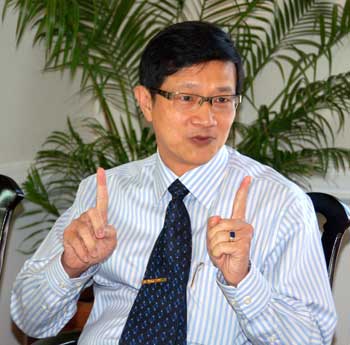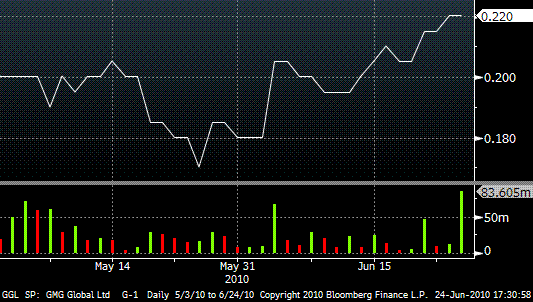'Bountiful Harvest - Agricultural Roadshow" organised by Financial PR
First report


FIRM RUBBER prices are a key reason why GMG's CEO, Mr Elson Ng, believes GMG is a stock fund managers should pick up.
The other consideration: the vast land bank of GMG.
GMG owns over 40,000 hectares of rubber plantations in Central and West Africa, and has a 10-year expansion plan there.
The management believes that its demonstration of commitment to the African community will open doors with bureaucrats when it tenders for land bank.
In the past decade, GMG has gone the extra mile in the building of African republic Cameroon, where it is the largest rubber producer.
Its list of social contributions read like a missionary report, ranging from provision of housing, schools, hospitals, micro-financing small farms to sponsorship of festivities and funerals.
Longer-term, GMG is looking at the vast continent of Africa to address the wider issue of a shortage in the supply of arable land in today's agro-economy.
Africa covers more than 20% of the world land area.
For fund managers, other than its vast natural resources, Africa's beauty lies in its infancy stage of economic development.
At Monday's road show organized by Financial PR showcasing four agriculture-related businesses, Mr Ng addressed queries raised by fund managers, analysts and traders. Extracts of the Q&A session:
Q: What do planters do during the first 7 years when the rubber trees are still growing and not yet mature for tapping?

A plantation has different stages: not all trees are mature for tapping. Some are getting old and need to be felled while others are still growing.
Large industrial planters such as GMG hold a big aggregate of mature as well as maturing plantations.
So what do you do when you plant and there is no income?
While waiting for the immature trees to grow, we
1. Maximize yield from our existing matured plantations; and
2. Buy rubber from third parties such as smallholders for processing.
58% of rubber sold by GMG in FY07 came from smallholders and other third party planters.
Unlike plantations for crops that can be harvested in a year or less, rubber plantations take 7 years to mature.
To address this 7-year wait, other than knowing agricultural economics, rubber planters need a financial plan.
A simple arithmetic illustration explains the importance of financing:
When rubber was trading at about US$1,000 a ton 3-4 years ago, buying 30,000 tons of rubber from third parties required working capital of US$30 million.
Now that prices have broken past US$3,000, banking facilities and immediate cash flow requirements for buying rubber from smallholders during planting stage have trebled.
Escalating rubber prices therefore make it harder for small-scale planters to enter the trade.
Q: What’s the cost structure for a plantation like yours?

In Africa where we operate, costs are denominated in Euro.
Rubber is sold in USD and Euro. Thus, appreciation of the Euro inflates our costs. Nevertheless, rubber plantations in Africa are much more lucrative than in Indonesia or Thailand.
In the Ivory Coast for example, there is a well-regulated price mechanism set by its government for smallholders and processors to reap the upside of increase in rubber prices.
Q: Do buyers switch between synthetic and natural rubber - i.e. are prices inter-linked?
Synthetic rubber is an immediate substitute for natural rubber.
Demand for synthetic rubber is 12 million tons a year, compared to 10 million tons of natural rubber. That 55:45 ratio has been stable over the years.
68% of natural rubber goes into automobile tires. Each group has its unique end users with the exception of car tire makers. Saloon car tires are made of both synthetic and natural rubber.
Q: Is there a seasonality in your business?
Yes, the second half of the year is the period to watch for rubber plantations as it contributes the major part of sales volume and profitability.
Assuming stable prices, first half generates 35%-40% of production volume while 60%-65% comes from second half.
Cameroon and the Ivory Coast are above the equator, which means there is a wintering period in late March and early April.
This is when trees grow new leaves and workers take leave to go home. Wintering period in Palembang is during June to July.
Q: Do you have plantations in Indonesia?
We only have a factory at PT Bumi Jaya, which buys rubber from smallholders. We have 1,000 hectares of matured plantations in Cameroon and 1,000 hectares of matured plantations in the Ivory Coast.
Q: What is the break down between your matured and immature plantations?
|
Hectares |
Mature | Immature |
| Havecam in Cameroon |
16,600 |
23,400 |
| Tropical Rubber Cote d’Ivoire in Ivory Coast |
1,000 |
500 |
| Total |
17,600 |
3,000 |
Q: What will your planting schedule be like?
The schedule depends firstly, on climatic conditions, and secondly, on availability of equipment.
We need to clear land at the right climate and wait for the right planting season.
Africa does not produce equipment, so we either build or import what we need.
For faster expansion, we would need to import machinery, as well as hire workers from China or India.
We hope to plant about 2,000 to 3,000 hectares each year. There are 660 trees on each hectare of our matured plantations.
Due to tree loss, only 400-450 trees are left when we eventually fell the plantation (after about 20 years).
450 trees will be planted on each hectare at our new plantations.

Q: What is your yield per tree?
Yields in Africa are more than 50% higher than in Indonesia.
In Indonesia, each hectare yields an average of 1.3 tons of rubber a year.
Smallholders are relatively inefficient; each hectare yields 0.6 tons a year to a maximum of one ton.
This is because they do not have prime seedlings, lack fertilizers and may employ an inefficient tapping system.
Further, they spend minimal effort in maintaining immature plantations. Before the tapping stage, they may find alternative employment such as being transportation workers.
In assessing tree yield, other than making sure formulae are comparable, one should adjust for worker productivity and occurrence of brown trees (for which latex supply have dried up).



